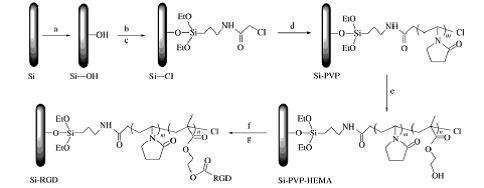Protein adsorption and cell adhesion on RGD-functionalized silicon substrate surfaces
Chinese Journal of Polymer Science,
2013,
31,
495-502.
文章链接:http://dx.doi.org/10.1007/s10118-013-1210-2
童伟芳同学在Chinese Journal of Polymer Science发表研究论文
发布日期:2013-01-08
A method was developed to modify silicon surfaces with good protein resistance and specific cell attachment. A silicon surface was initially deposited using a block copolymer of N-vinylpyrrolidone (NVP) and 2-hydroxyethyl methacrylate (HEMA) (PVP-b-PHEMA) film through surface-initiated atom transfer radical polymerization and then further immobilized using a short arginine-glycine-aspartate (RGD) peptide. Our results demonstrate that the RGD-modified surfaces (Si-RGD) can suppress non-specific adsorption of proteins and induce the adhesion of L929 cells. The Si-RGD surface exhibited higher cell proliferation rates than the unmodified silicon surface. This research established a simple method for the fabrication of dual-functional silicon surface that combines antifouling and cell attachment promotion

